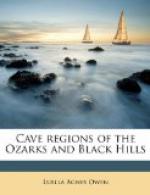To properly picture the twenty miles of changing and charming views between Galena and Marble Cave would require the light and skillful touch of a special artist gifted with a tangible perception of atmospheric values. Gradually the road forsakes the pretty valleys with their fields and streams, to take the summit of the hills and then be known as the “Ridge Road,” which affords a wide range of vision not previously enjoyed, presenting scenes not to be found reproduced elsewhere with any degree of exactness. Looking into the depth of the forest as it slopes away on either side, the impression is of a magnificent park, undefaced by what are called improvements. This effect is produced by the scarcity, or entire absence of underbrush, and a beautiful surface covering of grasses or flowering plants of all kinds and colors, varied here and there with masses of ferns of unusual size and delicate beauty. The most unexpected and lavish feature of the rich display is the many miles of fragrant honeysuckle that grows only eighteen inches high in the forest shade, but if transplanted to a sunny spot develops into the familiar vine. The most beautiful portion of all this is called The Wilderness, and seems designed for a National Park. Such a park reserve, even if very small, could not fail to be a lasting pleasure, since it would be more accessible to large centers of population than other reserves, and its most delightful seasons are spring and autumn when the Yellowstone is under snow.
[Illustration: A Mill-Site Near Marble Cave.]
The distant view obtained through open spaces is an undulating forest in all directions, being apparently both trackless and endless. The great variety of greens observed in the foliage blends in the distance into one dark shade, then changes to dark blue, which gradually fades out to a hazy uncertainty where it is lost at the sky-line.
As long ago as 1853, the variety and abundance of the natural growth of fruits throughout the Ozarks was observed by Professor Swallow, who then advised the planting of vines.
Beyond the Wilderness is the Marble Cave property and the entrance to the Cave is through a large sink-hole in the top of Roark Mountain. This hole is said to be about two hundred feet long, one hundred feet wide and thirty-five feet deep. It is shaped like a great oblong bowl with sloping sides, divided irregularly near the middle, and having the bottom broken out in a jagged way that is very handsome and gives an ample support to the growth of ferns, wild roses, and other vegetation with which it is abundantly decorated. About half of the descent into the basin is accomplished by scrambling down the roughly broken rocks, and the balance by a broad wooden stairway ending at a narrow platform that supports the locked gate.
For kind and valuable assistance rendered to insure the success and pleasure of the visit to the wonderful cave, which they regard with affection and pride, very cordial thanks are due to Capt. T.S. Powell, former manager, his son, Mr. Will Powell, the first guide, and Mr. Fred Prince, who has made the only official survey and map. It may be stated here that the survey and map are far from complete, and many known passages have never yet been entered.




